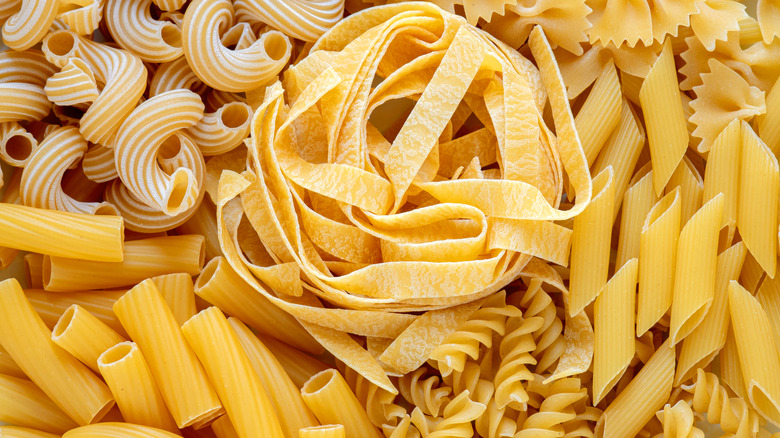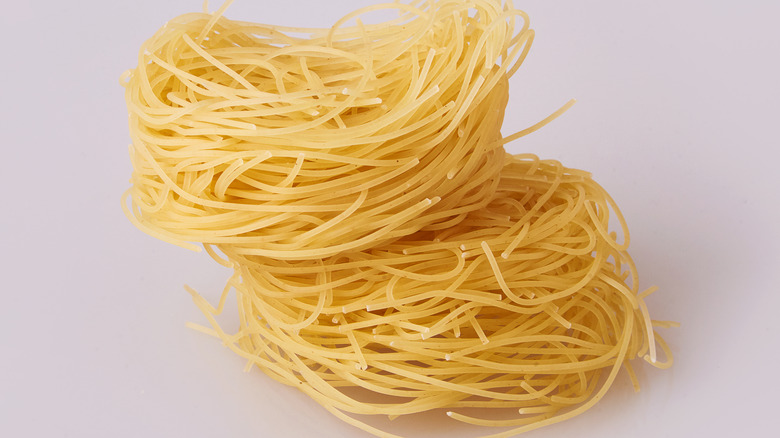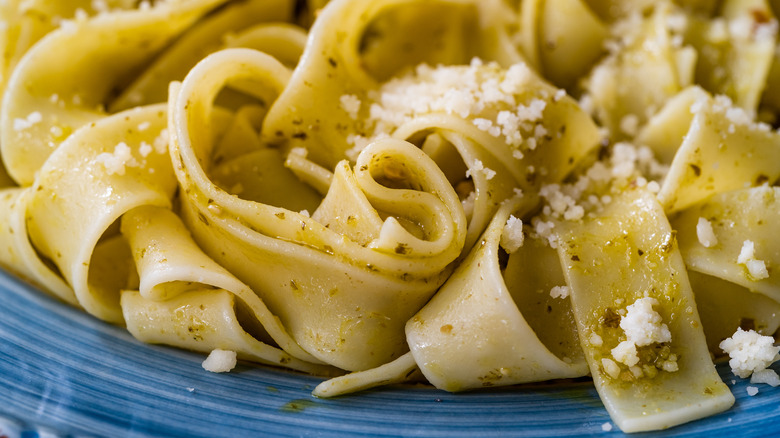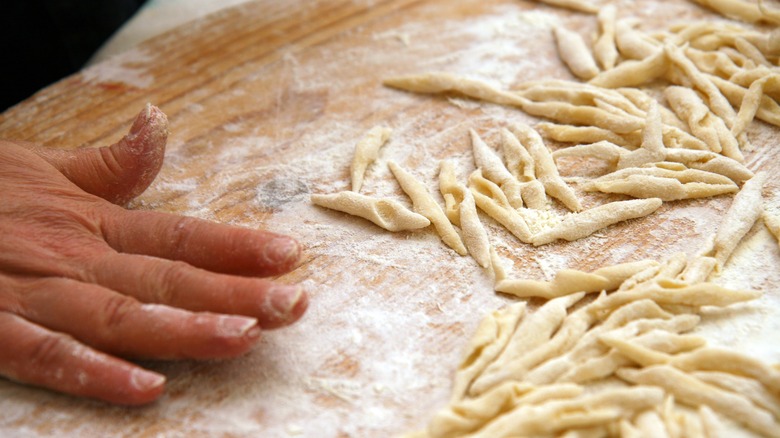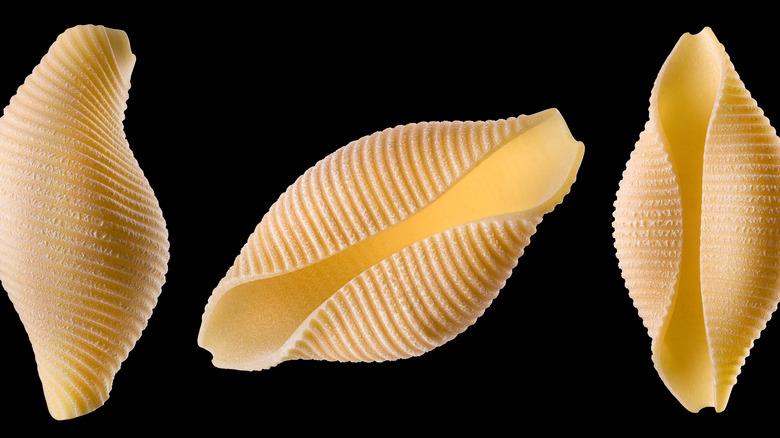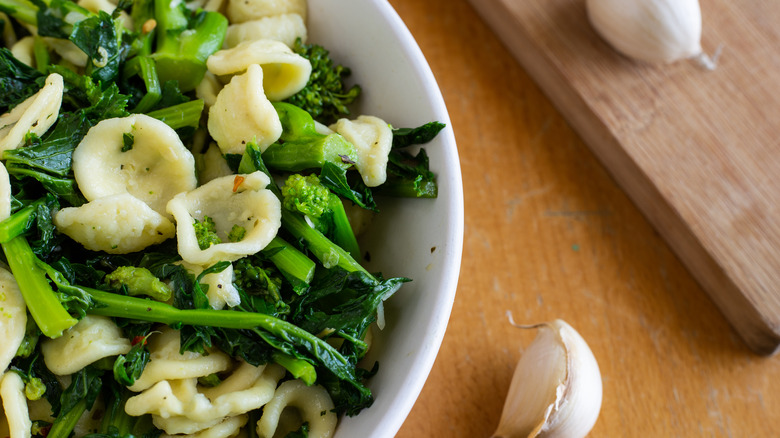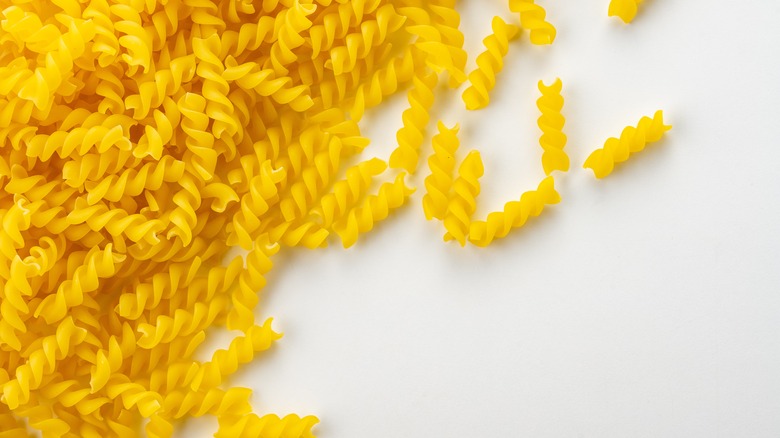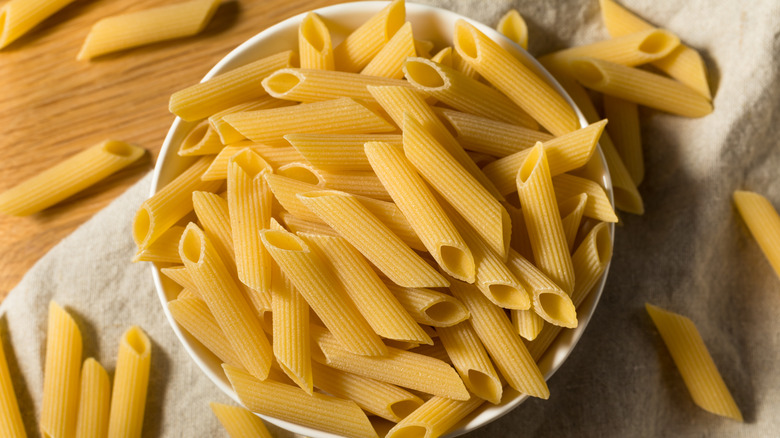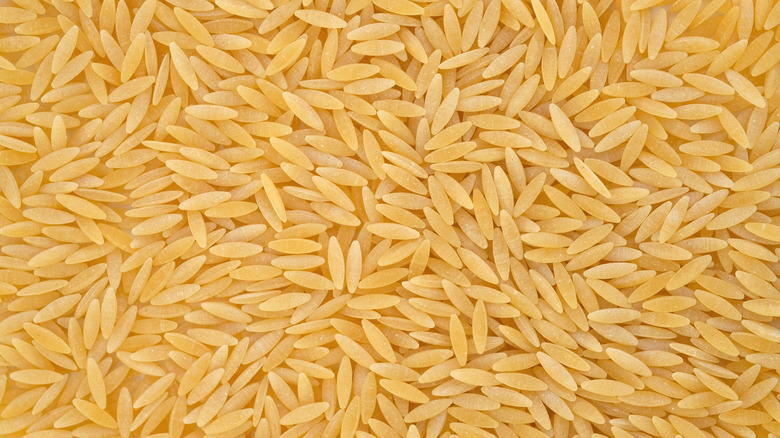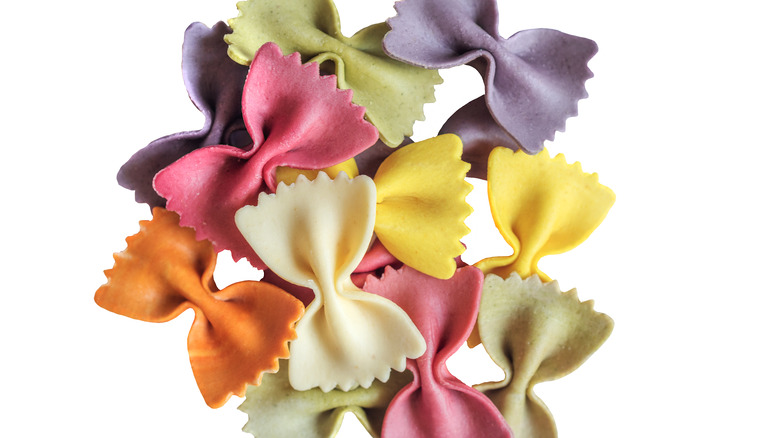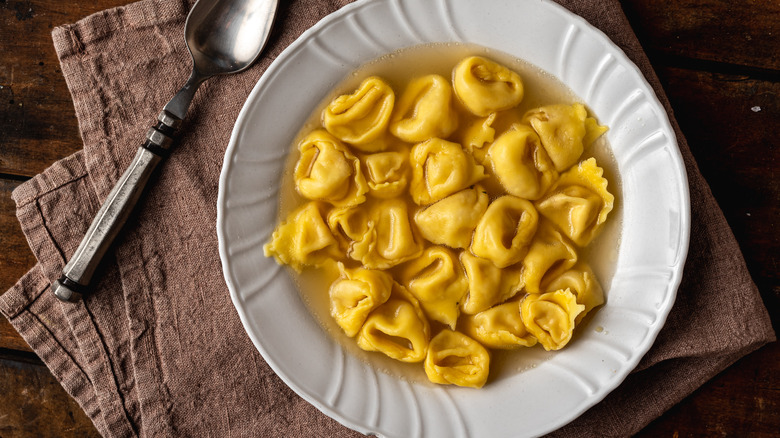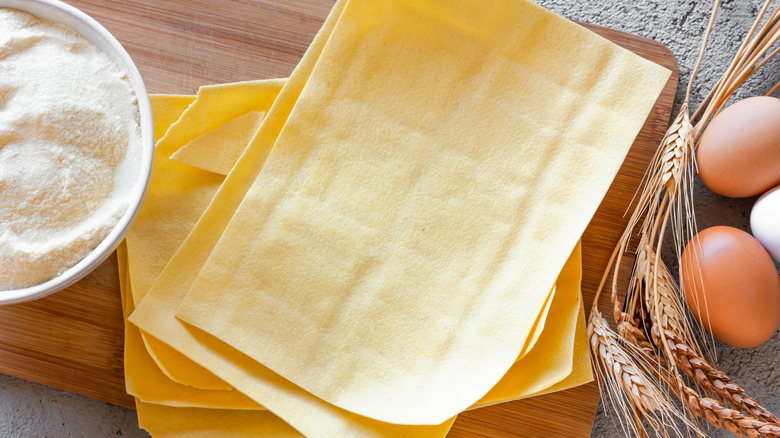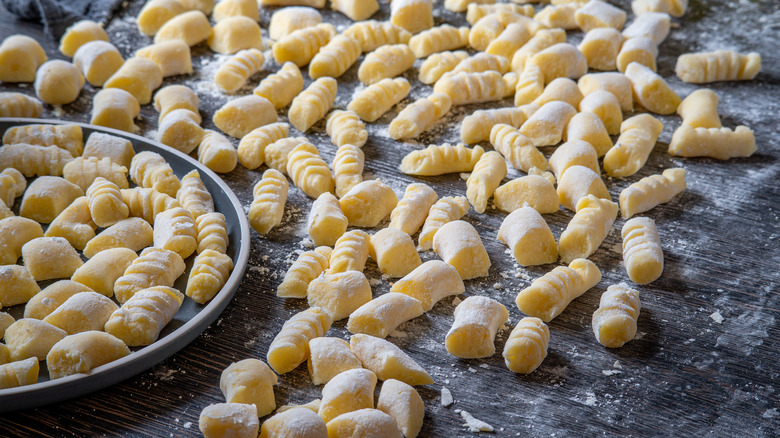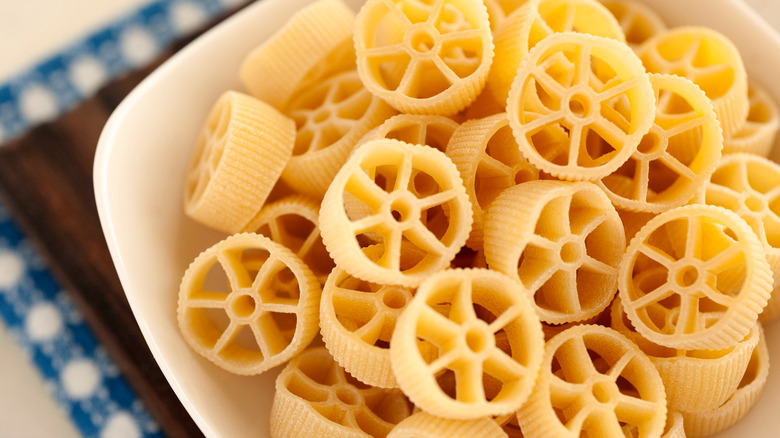A Guide To Pasta Shapes And The Best Way To Use Them
People across cultures have been making and cooking pasta for centuries, resulting in a wealth of pasta styles. What began as a regional foodstuff spread across the world, becoming something that is almost an essential part of the food pyramid. It's often thought that Marco Polo brought it back from China, where noodles were made from rice flour, according to historian Harold McGee in On Food and Cooking: The Science and Lore of the Kitchen. But while the Chinese did develop the art of the noodle, McGee claims that other pastas already existed in Europe even before then.
The beauty of pasta is its versatility. You're just as likely to eat it at home as comfort food as you are in a fine restaurant. A bowl of pasta is like a canvas waiting for a masterpiece, with as many different toppings and sauces as there are colors of paint in the world. The Los Angeles Times reports that what makes pasta so adaptable is its variety of shape and texture, along with how easy it is to make. Though the ingredients are essentially the same (flour, water, and/or eggs, writes Allrecipes), dishes can taste drastically different depending on the preparation, which is determined by form. The geometry of the pasta dictates which sauces, vegetables, and proteins work best in combination. So, knowing your ABCs of pasta shapes can help you boil an ordinary dinner into a memorable meal.
Skinny strands
Often, long, skinny pasta is simply called spaghetti, says The Pasta Project. Translating to "little twine" in Italian, the strands are made in different widths, and each one has a different name, from angel hair, capellini, and fettuccini, to spaghettoni and bucatini. As the styles get wider, the ways to prepare the pasta increase. And certain recipe strategies work best with certain widths.
Recipe Tips suggests this rule of thumb: the thicker the pasta, the denser the sauce. Thinner spaghettis should be paired with lighter, delicate sauces or oil, which will coat the fragile strands evenly without weighing them down. So, for thin angel hair, use a thin sauce instead of a hefty one loaded with vegetables or meat. For wide spaghettoni, use a chunkier sauce, such as a carbonara, says pasta-maker Barilla. Its dimensions will easily handle the weight of the sauce without clumping or collapsing. Twirling will be easier, too.
Ribbon style
Ribbon-shaped pasta is well-suited for many preparations. You can choose from a full range of widths, including linguini, fettuccine, tagliatelle, and pappardelle. Despite their varying dimensions, most ribbon pastas will work with most recipes, so which one you choose comes down to preference. Here are a few points to note.
First, linguine. In Italian, linguini translates to "little tongues." Thinner than other flat varieties, it pairs best with medium-bodied ingredients. Think vegetables, pesto, or seafood-based dishes. As with spaghetti, the wider you go with ribbons, the heartier your sauce can be. There's simply more room to hold it. Next, fettuccini and tagliarini do well with meat and cream sauces. Thicker noodles are often rolled out with wooden pins, which gives them a texture that heavier sauce can grip, says Francine Segan in La Cucina Italiana. Finally, tagliatelle and pappardelle are the widest pasta choices in this category, and both are egg-based, an attribute that gives them a deep flavor when matched with a rich ragu or heavy, cheesy sauce.
Short and skinny
There is no denying that images of ribbons and strands pop into your head when you think of pasta. But if you're looking to get creative in the kitchen, there are many more shapes to try, notably, the short and skinny ones. Generations ago, these developed a particular reputation for being so consumable that they earned the name strozzapreti, or "priest strangler," as Delishably writes. Imagine that: pasta so good that even air can wait.
Some of these short noodles are made from two strands, twisted together. Strozzapreti — and its shorter cousin casarecce — are the forms of pasta made when two strands are wrapped around each other and then cut short, according to The Pasta Project. The result is something a few inches long, with a shape all its own. According to CooksInfo.com, this pasta is often served with chunky sauces consisting of vegetables or meat. Twisted pastas like strozzapreti have a tiny channel in between the twists, allowing sauces, oils, and small bits of ingredients to cling to the pasta and its wider surface area, says MasterClass. The result is something you can spike with a fork, but you'll likely want to inhale.
Shells
When it comes to childhood comfort foods, the endless range of shell-shaped pasta deserves a word. The differences come down to size and texture. The smallest is conchigliette, which you'll often find paired with a box of Velvetta. Conchiglie is next, and then the jumbo-sized conchiglioni. In addition to this collection of shells, there is lumache, which resembles a snail's shell.
As it turns out, Velvetta's use of shell pasta as a mac-and-cheese base is a good example of how to prepare this style. Shell pasta is a perfect pairing for rich, creamy sauces, says BBC Good Food. Its cavity will become a flavor-filled reservoir when stuffed and baked with soft cheese and vegetables, according to The Pasta Project. Similarly, larger shells such as conchiglioni and lumaconi have more surface area for delicate or thin sauces to spread over. All in all, shell pasta is a fun shape with many uses, each one giving adults permission to play with their food again.
Scoops
Scoop-shaped pasta falls somewhere in between the deep wells of shells and the flat surface of ribbon cuts. They are also less common, so they'll give your meal a festive and unexpected kick. A common type of scoop is orecchiette, which means "little ear" in Italian. This shallow, bowl-shaped pasta provides a cradle for sauce and other ingredients. Per Spoon University, the dome-like profile of orecchiette can catch chunks of hearty vegetables or bits of meat.
Other scoops include gigli, which has a cone-shaped profile that allows sauce to pour right in. The blooming lily shape, also called campanelle, opens into a wide flute that can catch and hold small bits of ingredients. Less textured, smoother dressings are better suited to fill in the trumpeted scoop while also clinging to the exterior of this pretty pasta. Chunky sauces don't have much to work with gigli and campanelle, as they have little surface area.
Twists
Spirals are common shapes that line grocery store shelves. Whether fusilli, rotini, cavatappi, and ultra-short radiatori, twisty noodles are versatile and easy to cook. There are, though, subtle differences between a corkscrew and a spring, for example, which can make for a different experience when it comes to density and texture. The one thing they all have in common? A firm and bouncy bite when prepared properly al dente.
Fusilli's spiraling shape has ruts that are great for catching sauces and trapping gobs of meat and vegetables, says Share the Pasta. Its cousin rotini is more of an Americanized pasta, but this doesn't stop it from having similar cooking uses. Whether it's a creamy carbonara or a chunky bolognese, hefty toppings are a great pairing for twisted pasta.
As for the shortest of the bunch, radiatori has deep cuts that pair nicely with finely chopped morsels, says The Pasta Project. This makes sense, as the short coils don't appear big enough to hold onto larger pieces of food. But just because you're avoiding bulky toppings doesn't mean you have to drop thick pasta sauces too. As we've reported here at Mashed, radiatori can handle dense toppings as long as they're smooth.
Tube pasta
Another style that holds chunky sauce well is the tube. It's made in a range of sizes, from the long length and wide diameter of cannelloni to the shorter penne, rigatoni, and ziti. It may be considered a controversial opinion among pasta aficionados, but The Spruce Eats even considers the thin, narrow, and hollow shape of bucatini pasta to be tubular enough to fit into this category. When it comes to the pipe-shaped pasta set, sucking up sauces is the mission of the meal.
It all boils down to the size of the hollow channel inside the pasta, which holds the sauce. The more available volume, the more sauce to hold. Large, wide styles of tube pasta (ziti and cannelloni) excel when it comes to "studded sauces." Italian food importer Delallo writes that hollow pasta such as penne and rigatoni also make good baking ingredients, and their empty middles also equip them to pair perfectly with both velvety and burly sauces. Even among penne, there is diversity. Penne rigate (with ridges) is better suited for thick toppings while mostaccioli (smooth penne) is good for lighter ones, according to MasterClass. Additionally, we've classified bucatini as a tubular pasta, but you'll get the best results using it in similar ways to ribbon or strand pasta.
As for thin bucatini? This narrow tube can hold up well to any of your favorite sauces, but the best way to coat the inside of the pasta is with a silky sauce that's easy to slurp through the straw-like center.
Granular pasta shapes
Pasta can be simple, and pasta can be sophisticated. But sometimes, you just want pasta to be easy. You could argue that there is nothing really difficult about gobbling noodles, except that sometimes it can get messy and that becomes trouble in itself. One of the neatest and most straightforward pasta shapes is the granular style. Couscous, often mistaken as a grain, is one type of miniature pasta that couldn't be more uncomplicated. Another is the rice-shaped orzo pasta. Granular pasta will be your ticket to a quick but substantial dinner.
Couscous is a staple food that hails from the Berber rulers of Algiers, Morocco, and Tunisia, says The Washington Post. These cuisines are spice-heavy, so the neutrality of this small but mighty starch makes it an excellent pairing for zesty foods, says Epicurious. Additionally, topping it with butter, oil, or light seasonings will give you a fluffy dinner side. Moroccan couscous is a smaller variety typically found in the grocery store, and it works as a good substitute for breadcrumbs when making foods such as meatballs or meatloaf. The pea-shaped Israeli variety is closer in texture to traditional pasta.
Orzo is a small rice-shaped pasta that has similar uses to couscous. It's also a great addition to soups. Greeks and Italians have been using orzo as a soup ingredient for generations, according to The New York Times. You can also serve it chilled with lighter toppings such as olive oil and lemon, butter, or vinaigrette. Finely chop onions, peppers, or spinach and toss in capers for a flavorful dish.
Bowtie pasta
Grain-style pasta may be the out-of-the-box choice for your soups or stew, but for many, bowtie-shaped pasta are perfect for broths. Small enough to be spooned up, but large enough to add substance, the pretty shapes add weight and style to all types of soups. And, while we call them bowties, farfalle is actually shaped after butterflies, according to pasta company Barilla.
Because of its folds, creases, and surface area, farfalle adapts to many preparations. The ruffles and sturdy wings stand up to luxurious sauces, Food Network writes. And the wide edges can catch and carry pesto from your bowl to your mouth just as well as it can carry creamy tomato toppings or light oils, says Spruce Eats. The foodie site also describes it as an excellent choice for cold options, not to mention the classic pancetta and pea with parmesan. When preparing, be sure to boil long enough for the cinched centers to cook.
Stuffed pastas
Nothing says effortless meal like stuffed pasta. Infused with taste and loaded with all sorts of cheese, pureed veggies, meats, or herbs, these flavor pockets are reliable answers to a rumbling stomach. The most well-known styles are ravioli and dumpling-esque tortellini, though the more niche mezzelune (which resembles an Italian empanada) is also choice to have around, says Taste Atlas. Often a celebratory food for Italians, according to Culture Trip, ravioli can make any occasion feel festive. Serve it with sauce, or embrace its stuffing and leave it bare.
Tortellini has a unique relationship to being in the buff. Journalist Sylvia Poggioli reports for NPR that the idea for this pasta shape was inspired by the navel of the ancient goddess Venus, depicted in a famous Renaissance painting by Sandro Botticelli. "The Birth of Venus" shows a woman floating across a lake, a familiar scene for pasta lovers who traditionally eat tortellini as a soup dumpling, according to La Cucina Italiana. And while you can certainly serve it dressed in a range of sauces, this stuffed pasta is happiest being blown across a brothy bowl.
Whether in soup, sauce, or served plain, stuffed pasta is the filled treat that will leave your belly bursting.
Sheet pasta
Sheet pasta, also known as lasagna, is not as low-maintenance as stuffed pouches of ravioli. We find that it isn't as quick to cook as rotini, and it doesn't catch sauce in the same way as orecchiette. When it comes to pasta shapes, cooking sheets is more involved. And you'll need more time. But the cheesy, toasty goodness that will emerge from your oven is well worth the patience.
Sheet pasta works best stacked between various layers of ingredients. Then, let the oven do the work. Sauce, cheese, meat, veggies, or seafood may be alternated with the pasta in a large flat baking dish. According to The Pasta Project, anything can (and should) be fit inside a lasagna. Consider swapping a creamy bechamel and adding minced shrimp rather than the standard meat and tomato ragu. Or, use spinach-infused lasagna sheets to get an extra dose of vitamins or color, suggests La Cucina. Lasagna provides an extra benefit — you can store it in your fridge, well-wrapped, for about three days or freeze it for up to two or three months, says "Taste of Home."
Gnocchi
Gnocchi is actually the predecessor to many other forms of our favorite pasta, says Saveur Magazine. A wide array of ingredients are used to make gnocchi, a plump dumpling that often has ridges scoured into the sides, but it's known mainly as a potato pasta. Gnocchi is made from a paste-like dough, which is rolled into ropes, sliced into cubes, and boiled until they float. Many preparations include searing them in a pan afterward.
Unlike its dumpling cousin, tortellini, gnocchi is not typically served floating in broth. Because of its soft texture, it has a high chance of becoming gummy when drenched in broth or boiled for too long, says Bon Appétit. Instead, consider frying and roasting it. The cooked texture should be soft and supple, while the flavor is neutral like the potato it takes to make them. It makes a delicious and satisfying base for a bright, tangy tomato sauce. The ridges will grab on to ingredients
Wheels
Round up the wagons. The wheel pasta shape is the kind of food that kids both young and old enjoy. Formally called rotelle, the pasta comes in a variety of sizes, but the shape is mostly the same. If you're a more serious eater, you might find yourself asking, "Is this pasta actually good for more than a gimmick?"
The answer is yes. In our opinion, the best use for rotelle is that it makes eating fun. Parents know the value of foods that can entertain a kid who doesn't want to eat. Enjoyment aside, the spokes are really good at trapping chunks of ingredients, Food Network says, so try any sort of sauce that you like. The wheels are also a smart choice for pasta salads; choose a size that is similar to that of your cut ingredients. And as always, wagon wheels can make that afternoon bowl of butter noodles a rolling success.
